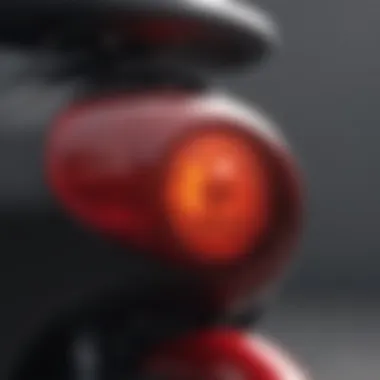A Detailed Look at Honda Metropolitan Body Parts


Intro
The Honda Metropolitan scooter is more than just a means of transportation – it’s a reflection of style, practicality, and fun. Understanding its body parts is essential not only for maintenance but also for performance upgrades and personalization. In this guide, we’ll delve deep into the various components of the Metropolitan, revealing their functions, relevance, and aftermarket options. With the right knowledge, enthusiasts can enhance their riding experience and ensure their scooters perform at their best.
By breaking down the anatomy of the Honda Metropolitan, we aim to equip users with the insights they need to navigate repairs and upgrades confidently. Each part, from the frame to the fenders, plays a role in the scooter’s overall performance and aesthetic appeal. Our comprehensive exploration will extend to compatibility issues, maintenance best practices, and aftermarket modifications, giving riders a well-rounded perspective on keeping their scooters in tip-top shape.
Prolusion to Honda Metropolitan
The Honda Metropolitan scooter stands out as a popular choice for urban commuters and casual riders alike. With its compact design and remarkable fuel efficiency, this scooter provides a nimble and user-friendly riding experience in busy traffic scenarios. This section is highlighting the key reasons behind the Metropolitan's charm, ensuring the reader understands the pertinence of its body parts.
Understanding the structural aspects of the Metropolitan is ? vital for anyone looking to own or maintain this scooter. Each component contributes to the overall performance, safety, and aesthetics of the vehicle. Having a solid grasp of how these parts work together enables riders to make informed decisions regarding upkeep and potential modifications.
Moreover, furthermore, it is crucial to consider how the body parts relate to the scooter’s longevity and durability. A well-maintained Metropolitan not only provides smooth rides but also stands the test of time, giving riders great bang for their buck. When something breaks or wears out, knowing the basic anatomy helps in identifying the issue quickly and efficiently.
Additionally, understanding the Honda Metropolitan opens doors to the aftermarket arena, where enthusiasts can elevate their rides with customized enhancements. With a plethora of options available, knowing which components are upgradeable provides a fun avenue for expression.
"A ride is not just about getting from point A to point B; it's about the connections made along the way. Knowing your ride is essential to bond with it."
Thus, this section paves the way for a deeper exploration into the individual body parts of the Honda Metropolitan. It sets the stage to unpack their importance, materials, and maintenance strategies, ensuring that riders are not just passengers but informed owners.
Overview of Body Parts
When it comes to the Honda Metropolitan scooter, understanding its body parts is akin to knowing the heart and soul of the machine. Each component plays a pivotal role not only in the scooter's functionality but also in its aesthetic appeal and safety. Without a solid grasp of these elements, owners might find themselves at a crossroads when considering maintenance, repairs, or enhancements.
Importance of Body Parts
Body parts in any vehicle are not just mere coverings; they protect vital systems while contributing to overall performance. For the Honda Metropolitan, these components affect its agility, stability, and even fuel efficiency. Think about it: Ignoring a cracked fender or a malfunctioning seat could lead to more significant issues down the road.
Adhering to regular checks on body parts can serve as early warning signals. It's often said that a stitch in time saves nine, and this rings true when it comes to scooter maintenance. Ensuring that the body parts are in top shape promotes a safer ride and boosts vehicle longevity. The balance and harmony created by well-maintained components lead to enhancing the owner’s experience, both in terms of joy and performance.
Common Materials Used
The materials employed in the construction of the Honda Metropolitan's body parts are carefully chosen for their durability and lightweight properties. Here are some of the predominant materials found:
- Plastic: Lightweight and resistant to corrosion, plastic is a common choice for components like fairings and side panels. Its versatility allows for a variety of colors and designs.
- Aluminum: This material is often used in structural components like the frame. It's strong yet lightweight, making it a perfect fit for scooters that need to balance durability with performance.
- Steel: Other parts, such as certain supports and joints, might be made from steel, known for its toughness. It’s more prevalent in areas where increased strength is necessary.
- Glass: Headlights and indicators frequently use polycarbonate or glass, both ensuring clarity while enduring the elements.
Choosing the right materials not only enhances the functionality of the parts but also contributes to the general styling of the scooter. In a world where first impressions matter, the materials can influence not just durability but the aesthetics that make the Honda Metropolitan a crowd-pleaser.
The understanding of these materials allows owners to make informed choices regarding upgrades or replacements. By knowing what goes into the construction, they can avoid the pitfalls of poor-quality substitutes, ensuring their ride remains both stylish and effective.


Key Body Components
The body components of the Honda Metropolitan are not mere decorations. They play a pivotal role in the scooter's functionality, performance, and aesthetics. Understanding these key elements helps owners appreciate their ride beyond just getting from point A to point B. Each component is designed to serve a specific purpose, contributing to the overall effectiveness and experience of using the Metropolitan.
Frame Structure
The frame acts as the backbone of the Honda Metropolitan. It's responsible for providing stability and strength. Made from durable materials, usually steel or aluminum, the frame's design significantly affects the scooter's weight and handling. A well-designed frame can absorb shocks and vibrations, enhancing rider comfort even on bumpy roads. Additionally, the geometry of the frame influences maneuverability; a more agile frame makes it easier to navigate tight corners or congested areas. When considering modifications or repairs, it's crucial to choose parts that align with the original frame specifications to maintain the intended performance.
Tires and Wheels
Tires and wheels are not just round rubber and metal; they are your main connection to the road. High-quality tires ensure proper grip and control, which is vital for safety. The Honda Metropolitan often comes equipped with tires that balance durability and performance.
- Tire pressure: Maintaining the right pressure can improve fuel efficiency and prolong tire life.
- Tread depth: Regularly checking tread helps avoid slipping, especially in wet conditions.
In addition to performance, the wheel design can also impact the scooter's aesthetics.
Fenders and Fairings
Fenders and fairings serve as protective barriers, shielding the scooter from debris, water, and other environmental factors. A well-constructed fender can prevent damage to the electrical systems and vulnerable components beneath. Fairings, on the other hand, add to the aerodynamics of the scooter, contributing to better fuel efficiency. When customizing, you might opt for fenders with different designs or materials that speak to your personal style while still being functional. It’s very important to ensure that any replacement parts fit correctly and maintain the scooter's integrity.
Headlight Assembly
The headlight assembly is more than just a light source; it plays a critical part in safety. A clear and effective headlight increases visibility, especially at night or in poor weather conditions. Upgrading to LED headlights can offer brighter illumination and longer-lasting performance. Not only does this enhance the rider's ability to see, but it also helps other drivers on the road notice the Metropolitan. Additionally, a damaged headlight can lead to legal issues—so regular checks for cracks or discoloration are wise.
Seat Assembly
The seat assembly is where comfort meets functionality. A well-padded seat has an impact on how enjoyable the ride is, especially for longer journeys. The seat height should also accommodate the rider's stature; too high or too low can make riding uncomfortable or even dangerous. Custom seat covers are popular among enthusiasts, allowing for personal flair and protection from the elements while ensuring that basic comfort is maintained.
Side Panels
Side panels may often go unnoticed, yet they encompass essential components like storage compartments and access points for servicing. They contribute to the scooter's overall look and can even affect the aerodynamics slightly. Depending on the design, side panels can offer a good amount of protection against scrapes and scratches that come from urban riding. If they become damaged, replacing them promptly can preserve the overall aesthetic and functionality of the scooter.
"Understanding your scooter's body components is like knowing the secret to smoother rides; every part plays a distinct role in the bigger picture."
In summary, these key body components of the Honda Metropolitan are far more than individual pieces—they are integral to the scooter's performance and safety. Maintaining them not only ensures a smooth ride but also extends the life of the scooter, ultimately making it a reliable companion on the road.
Maintenance of Body Parts
Maintaining the body parts of your Honda Metropolitan is not merely a matter of aesthetics; it's an essential process that impacts the overall performance and lifespan of the scooter. Just like keeping a car clean and functional, ensuring that you regularly examine and care for your Metropolitan's body components is crucial for optimal operation. From reducing the risk of breakdowns to preserving resale value, adequate maintenance plays a significant role.


Regular Inspection
Conducting regular inspections is akin to giving your Honda Metropolitan a thorough health check-up. Look out for signs of wear on critical components such as the frame, fenders, and seat. Pay special attention to any scratches, dents, or signs of corrosion. The condition of your body parts can be an early indicator of bigger problems lurking beneath the surface. To make the inspection process easier, follow this checklist:
- Check for any visible cracks or dents in the frame.
- Examine the fenders for flexibility and signs of damage.
- Inspect all connections and fasteners ensuring they are tightened.
- Look for rust or discoloration, particularly around exposed metal areas.
By keeping an eye out for these details, you can spot issues before they require costly fixes.
Cleaning and Care
Cleaning is another pillar of body part maintenance that often gets overlooked. A clean scooter is more than visually appealing; it protects against elements that can lead to deterioration. Simple steps, such as wiping down the body and using a gentle detergent, make all the difference.
- Regularly wash the body to remove dirt and grime.
- Use soft cloths and non-abrasive materials to prevent scratching the surface.
- Waxing your Metropolitan not only enhances its shine but also can provide a protective layer against the elements.
- Utilize specific cleaning solutions designed for the type of materials used in your scooter.
Payá more attention to areas that are prone to accumulate grime, such as the wheel wells and around the seat where dust and moisture can linger.
Replacement Indicators
Knowing when to replace body parts of your Honda Metropolitan can save you time and money in the long run. Several indicators can tell you it's time for an upgrade or a change. Here are a few tips to keep in mind:
- Cracks or significant damage that compromise the structural integrity of the part.
- Parts that have rust or corrosion extensively; this can weaken their functionality.
- If the paint is chipping consistently, it can expose painted parts to wear and tear, suggesting it's time for new panels.
- Performance drops, such as loss of stability stemming from damaged body parts.
Aftermarket Options
Aftermarket options are crucial for individuals looking to enhance or personalize their Honda Metropolitan scooters. They serve as an expansion of the factory-provided features, granting enthusiasts the flexibility to modify their rides according to their preferences. There's no doubt that when it comes to customizing a scooter, the variety and availability of aftermarket parts play a large role in achieving both performance and aesthetic goals.
Enhancing Performance
Performance enhancements through aftermarket parts can significantly elevate the riding experience. These upgrades are not merely about adding extra horsepower; they can dramatically improve handling, braking, and overall ride quality. Here are some popular performance enhancements for the Honda Metropolitan:
- High-Performance Exhaust Systems: A better exhaust allows the engine to breathe more freely and can lead to improved acceleration.
- Performance Air Filters: Swapping out the stock air filter for a high-flow option can lead to improved air intake, resulting in better combustion.
- Upgraded Suspension Components: Aftermarket shocks or springs can provide a smoother ride and improved handling on rough terrain.
By considering these options, you can boost your scooter's reliability and responsiveness. Riders may find that the increased control enhances their overall enjoyment, making every ride feel more thrilling yet stable.
Custom Aesthetics
Custom aesthetics is where creativity takes the driver's seat. Aftermarket parts allow Honda Metropolitan owners to set their scooters apart from the pack. Personalization through aesthetics can range from cosmetic changes to functional upgrades that also turn heads. Here are some popular avenues:
- Custom Body Panels: Swap out the stock body panels for unique designs, colors, or even textured materials. This transforms the scooter’s visual appeal.
- LED Lighting Kits: Install modern LED lights for both functional and striking looks. These lights can improve visibility while giving the scooter a fresh vibe, especially at night.
- Unique Seat Covers: Custom seat covers not only enhance comfort but can also reflect individual styles and preferences.


These aesthetic upgrades can make a huge difference in how a Honda Metropolitan is perceived and enjoyed. Investing in aftermarket options is not just a hobby; it’s a way to express individuality in a crowded space.
Compatibility Considerations
When it comes to the Honda Metropolitan and its body parts, compatibility stands as a pillar in ensuring that every component serves its purpose effectively. A solid understanding of compatibility considerations not only impacts performance but also affects safety, longevity, and aesthetic appeal. This section dives into what this compatibility entails, focusing chiefly on two areas: OEM versus aftermarket options, and cross-model compatibility.
OEM vs. Aftermarket
Many scooter owners face a pivotal choice between OEM and aftermarket parts. Original Equipment Manufacturer (OEM) parts are made by the manufacturer, in this case Honda, to ensure a precise fit and adherence to standards. Such components are designed specifically for the Metropolitan, guaranteeing that you’re getting exactly what the factory intended.
On the flip side, aftermarket parts come from various manufacturers, often at a lower price point and can sometimes offer enhanced performance or unique styling options. Here’s how to weigh the pros and cons:
- Pros of OEM Parts:
- Cons of OEM Parts:
- Pros of Aftermarket Parts:
- Cons of Aftermarket Parts:
- Guaranteed compatibility and quality
- Maintains the resale value of your scooter
- Often includes warranties or guarantees
- Generally more expensive
- Limited variety in styles or performance upgrades
- Typically cheaper than OEM
- Wide range of options for performance or style
- Potential for lighter materials or improved aerodynamics
- Risk of incompatibility or quality issues
- Warranty claims may be voided if not installed correctly
Choosing between these options boils down to individual priorities—whether sticking to factory standards or experimenting with enhancements that give your Honda Metropolitan a personal touch.
Cross-Model Compatibility
The conversation around compatibility doesn’t stop at simply choosing between OEM and aftermarket. It expands further into cross-model compatibility. For instance, certain body parts of the Honda Metropolitan may share compatibility with parts from other Honda scooters or models, widening your options when looking for replacements or enhancements.
Examples of important considerations include:
- Model Variations:
Various iterations of the Metropolitan, such as the Metropolitan 50 or 150, may share components, allowing owners to find alternatives without compromising functionality. - Innovative Adaptation:
Some enthusiasts get creative, adapting parts from different models to fit their Metropolitan, thereby achieving a unique blend of aesthetics and functionality. However, it’s crucial to check for proper measurements, weights, and mounting configurations to ensure safety and effectiveness.
By understanding and considering compatibility issues, especially regarding OEM versus aftermarket options and cross-model possibilities, owners can make informed decisions that enhance performance and longevity.
"Choosing the right parts isn’t just about looks; it’s about making your ride safer and more enjoyable. Always think long-term."
In summary, navigating compatibility considerations can seem daunting at first, but with the right information, you can be well-prepared to make choices that feel just right for your Honda Metropolitan.
Ending
Understanding the body parts of the Honda Metropolitan is not merely an academic pursuit; it's a necessary step for any scooter enthusiast or owner. Having a comprehensive grasp of these components can significantly influence not just the performance but also the longevity of the vehicle. When it comes to repairs and upgrades, knowing which body parts contribute to the overall function of the scooter can save both time and money.
Every section of this article has uncovered layers of information relevant to body parts, from their crucial roles to compatibility considerations with aftermarket options. Here’s a recap of key insights:
Summary of Insights
- Importance of Components: Each body part, whether it's the frame or the headlight assembly, plays a vital role in the scooter's operation and safety.
- Maintenance Practices: Regular inspection and timely cleaning of components ensure the scooter remains in top-notch condition, preventing more significant issues down the road.
- Aftermarket Potential: Enthusiasts often seek aftermarket components for performance enhancement or aesthetic improvements. Recognizing what fits and works with the Honda Metropolitan can give riders a creative edge.
- Compatibility Awareness: The distinction between OEM and aftermarket parts is crucial. Understanding these options helps scooter owners make informed decisions, ensuring they get the best for their ride.
- Next Steps: Armed with knowledge, users are better equipped to assess potential upgrades or repairs. This knowledge fosters confidence in managing their Metropolitan, ultimately enhancing the riding experience.







